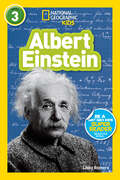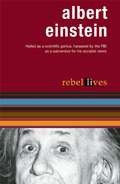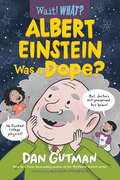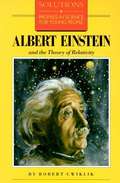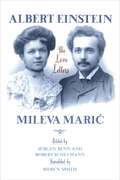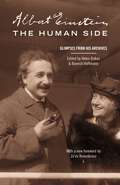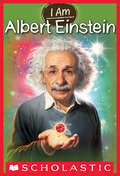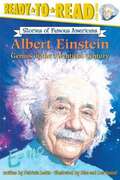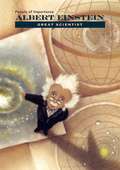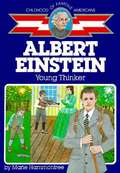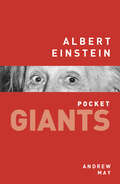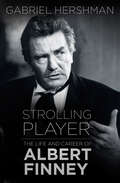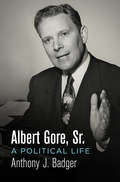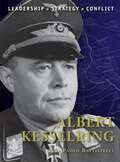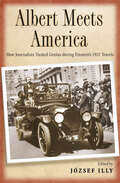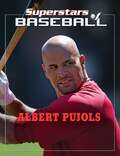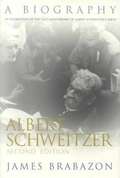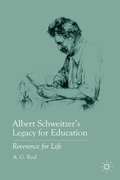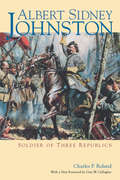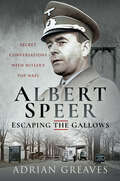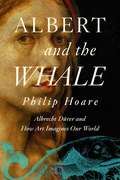- Table View
- List View
Albert Einstein (Readers Bios)
by Libby RomeroExplore one of the most recognized scientists in the world with this biography of physicist Albert Einstein. Kids will learn about his life, achievements, and the challenges he faced along the way. The level 3 text provides accessible, yet wide-ranging, information for independent readers.
Albert Einstein (Rebel Lives)
by Albert Einstein Tom KeebleEinstein as an absent-minded genius with his head in the clouds is a far cry from the real picture. A man deeply interested in social issues, Einstein felt it was his duty to use his fame and intellect to advance the cause of social justice.
Albert Einstein Was a Dope? (Wait! What? #0)
by Dan GutmanFrom the best-selling author behind My Weird School: a quirky new biography series that casts fresh light on high-interest historic figures. Did you know that Albert Einstein was a high school dropout, and that he failed his physics class when he finally made it to college? Or that when he died, his brain and eyeballs were removed from his body? Ever wondered why his hair looked so wild? Siblings Paige and Turner do—and they’ve collected some of the kookiest and most unusual facts about the world-famous scientist, from his childhood and school days through his time studying relativity and working on the atomic bomb. Narrated by the two spirited siblings and animated by Allison Steinfeld’s upbeat illustrations, Albert Einstein Was a Dope? expertly balances authoritative information with Dan Gutman’s signature zany humor.
Albert Einstein and Relativity for Kids: His Life and Ideas with 21 Activities and Thought Experiments (For Kids series)
by Jerome PohlenBest known for his general theory of relativity and the famous equation linking mass and energy, E = mc², Albert Einstein had a lasting impact on the world of science, the extent of which is illuminated--along with his fascinating life and unique personality--in this lively history. In addition to learning all about Einstein's important contributions to science, from proving the existence and size of atoms and launching the field of quantum mechanics to creating models of the universe that led to the discovery of black holes and the big bang theory, young physicists will participate in activities and thought experiments to bring his theories and ideas to life. Such activities include using dominoes to model a nuclear chain reaction, replicating the expanding universe in a microwave oven, creating blue skies and red sunsets in a soda bottle, and calculating the speed of light using a melted chocolate bar. Suggestions for further study, a time line, and sidebars on the work of other physicists of the day make this an incredibly accessible resource for inquisitive children.
Albert Einstein and the Theory of Relativity
by Robert CwiklikEinstein's astonishing theory of relativity transformed every aspect of physics-from the study of atoms to the study of stars. Relativity is described here in simple, accurate language that young readers can comprehend. From the back cover Written to challenge the imaginations of young readers, ages 12-13, Barron's exciting Solutions Series presents dramatic stories of brilliant scientists and their discoveries that have changed our civilization. The excitement of scientific challenge and the thrill of the solutions found by men and women of science make stories that will inspire and entertain youthful readers. Teachers will also value these volumes for their supplementary aids, including glossaries and topic lists for essays.
Albert Einstein, Mileva Maric: The Love Letters
by Albert EinsteinIn 1903, despite the vehement objections of his parents, Albert Einstein married Mileva Maric, the companion, colleague, and confidante whose influence on his most creative years has given rise to much speculation. Beginning in 1897, after Einstein and Maric met as students at the Swiss Federal Polytechnic, and ending shortly after their marriage, these fifty-four love letters offer a rare glimpse into Einstein's relationship with his first wife while shedding light on his intellectual development in the period before the annus mirabilis of 1905. Unlike the picture of Einstein the lone, isolated thinker of Princeton, he appears here both as the burgeoning enfant terrible of science and as an amorous young man beset, along with his fiance, by financial and personal struggles--among them the illegitimate birth of their daughter, whose existence is known only by these letters. Describing his conflicts with professors and other scientists, his arguments with his mother over Maric, and his difficulty obtaining an academic position after graduation, the letters enable us to reconstruct the youthful Einstein with an unprecedented immediacy. His love for Maric, whom he describes as "a creature who is my equal, and who is as strong and independent as I am," brings forth his serious as well as playful, often theatrical nature. After their marriage, however, Maric becomes less his intellectual companion, and, failing to acquire a teaching certificate, she subordinates her professional goals to his. In the final letters Einstein has obtained a position at the Swiss Patent Office and mentions their daughter one last time to his wife in Hungary, where she is assumed to have placed the girl in the care of relatives. Informative, entertaining, and often very moving, this collection of letters captures for scientists and general readers alike a little known yet crucial period in Einstein's life.
Albert Einstein, The Human Side: Glimpses from His Archives
by Albert EinsteinModesty, humor, compassion, and wisdom are the traits most evident in this illuminating selection of personal papers from the Albert Einstein Archives. The illustrious physicist wrote as thoughtfully to an Ohio fifth-grader, distressed by her discovery that scientists classify humans as animals, as to a Colorado banker who asked whether Einstein believed in a personal God. Witty rhymes, an exchange with Queen Elizabeth of Belgium about fine music, and expressions of his devotion to Zionism are but some of the highlights found in this warm and enriching book.
Albert Einstein: Albert Einstein (I Am #2)
by Grace NorwichMeet the scientist who changed the way we think about the universe!I am one of the most gifted minds that ever lived. I am a Nobel Prize–winning physicist. I was expelled from school as a young child. I am Albert Einstein.Learn all about this brilliant man whose scientific accomplishments are truly remarkable in this biography featuring:illustrations throughouta timelinean introduction to the other people you’ll meet in the bookmapssidebarsa top ten list of important things to know, and more
Albert Einstein: Genius Of The Twentieth Century (Ready-to-Read Sofa)
by Patricia LakinFrom a young age Albert Einstein was curious and very smart. But that didn't mean life was easy for him. In fact, being so smart sometimes made things harder for him! Read all about his life, and find out why Albert Einstein is known as the genius of the twentieth century.
Albert Einstein: Great Scientist
by Anne Marie SullivanAs a child, Albert Einstein was quiet and awkward. He had trouble making friends and problems with learning in the classroom. As Albert grew up, he began to use his mind in ways he didn't learn in school, leading him to become an expert in math and science. Einstein's ideas helped change the way scientists thought of the world around us and change the course of history in the atomic age. Today, Einstein is one of history's most famous scientists, and his theories have shaped science for decades. Learn about one of the most important scientists of all time in Albert Einstein: Great Scientist.
Albert Einstein: Scientist of the 20th Century
by Catherine ReefA biography of physicist Albert Einstein, the man who put forth the general theory of relativity.
Albert Einstein: Young Thinker (Childhood of Famous Americans Series)
by Marie HammontreeAll children know who Albert Einstein grew up to be--but what was he like as a child? A fictionalized biography of the childhood of the famous scientist.
Albert Einstein: pocket GIANTS
by Andrew MayEveryone has heard of Albert Einstein and everyone knows that he was a genius. Yet only a few people understand his work. In fact, he was just one of many brilliant scientists grappling with the deepest problems of theoretical physics during the first half of the twentieth century. He may not have been the most important or influential of them – the point is arguable – but there is no doubt he was the most revolutionary. Almost single-handed, he transformed the way the world thinks about light, matter, space and time.In the sixty years since his death Einstein has become a legend. The profound obscurity of his theories has contributed to this, as has his archetypal “mad scientist” appearance. His philosophical and political utterances – both real and imagined – are regularly used to clinch arguments online or in the pub. So how can a modern reader separate myth from reality? This short book attempts to do just that!
Albert Finney: A Well-Seasoned Life
by Gabriel Hershman‘Hershman has managed to gather a huge amount of information and distill it into a book that is not only respectful but full of insights into what makes this unstarriest of stars able to produce brilliant work without appearing to break a sweat.’ - Kathryn Hughes, Mail on SundayHe was a Salford-born, homework-hating bookie’s son who broke the social barriers of British film. He did his share of roistering, and yet outlived his contemporaries and dodged typecasting to become a five-time Oscar nominee and one of our most durable international stars. Bon vivant, perennial rebel, self-effacing character actor, charismatic charmer, mentor to a generation of working-class artists, a byword for professionalism, lover of horseflesh and female flesh – Albert Finney is all these things and more.Gabriel Hershman’s colourful and riveting account of Finney’s life and work, which draws on interviews with many of his directors and co-stars, examines how one of Britain’s greatest actors built a glittering career without sacrificing his integrity.
Albert Gore, Sr.: A Political Life (Politics and Culture in Modern America)
by Anthony J. BadgerIn chronicling the life and career of Albert Gore, Sr., historian Anthony J. Badger seeks not just to explore the successes and failures of an important political figure who spent more than three decades in the national eye—and whose son would become Vice President of the United States—but also to explain the dramatic changes in the South that led to national political realignment.Born on a small farm in the hills of Tennessee, Gore served in Congress from 1938 to 1970, first in the House of Representatives and then in the Senate. During that time, the United States became a global superpower and the South a two party desegregated region. Gore, whom Badger describes as a policy-oriented liberal, saw the federal government as the answer to the South's problems. He held a resilient faith, according to Badger, in the federal government to regulate wages and prices in World War II, to further social welfare through the New Deal and the Great Society, and to promote economic growth and transform the infrastructure of the South.Gore worked to make Tennessee the "atomic capital" of the nation and to protect the Tennessee Valley Authority, while at the same time cosponsoring legislation to create the national highway system. He was more cautious in his approach to civil rights; though bolder than his moderate Southern peers, he struggled to adjust to the shifting political ground of the 1960s. His career was defined by his relationship with Lyndon Johnson, whose Vietnam policies Gore bitterly opposed. The injection of Christian perspectives into the state's politics ultimately distanced Gore's worldview from that of his constituents. Altogether, Gore's political rise and fall, Badger argues, illuminates the significance of race, religion, and class in the creation of the modern South.
Albert Kesselring
by Adam Hook Pier BattistelliAlthough he is mostly remembered for his part in the campaign in Italy from 1943 to 1945, Generalfeldmarschall Albert Kesselring was also chief of staff of the Luftwaffe in 1936-37, playing a crucial role in the shaping of the service for the coming war. As commander of Luftflotte 1 in Poland and Luftflotte 2 in France and the Low Countries, he was responsible for supporting the armoured spearheads of the German Army as they undertook their Blitzkrieg campaigns. With the Fall of France, the Battle of Britain began and Luftlotte 2 was the main force in the air attack against the British air defences, with Kesselring planning many raids. Following the war Kesselring was tried and convicted of war crimes following a number of massacres of civilians in Italy. He was sentenced to death, later commuted to life imprisonment before being released on the grounds of ill health in October 1952. Here Pier Paolo Battistelli provides a detailed study of one of the most famous German commanders of World War II.
Albert Meets America: How Journalists Treated Genius during Einstein's 1921 Travels
by József IllyIn 1919, newspaper headlines said that a British expedition had confirmed Einstein's general theory of relativity. The news stirred the public imagination on both sides of the Atlantic and thrust the scientist into the spotlight of fame. Two years later, Chaim Weizmann led a fund-raising mission to the United States and invited Einstein to join it. The mission traveled to New York, Boston, Chicago, Cleveland, Philadelphia, and Hartford to campaign for public awareness and support of the Hebrew University of Jerusalem. This brought Einstein within the grasp of the American media. His lectures delivered in New York, Princeton, and Chicago, and comments on the Jewish presence in Palestine, made Einstein, on his first trip to America, one of the first media stars. In Albert Meets America, József Illy presents a fascinating compilation of media stories of Einstein’s tour—which cover his science, his Zionism, and the anti-Semitism he encountered. As we travel with Einstein, from headline to headline, we experience his emotional connection with American Jews and his frustration at becoming world famous even though his theories were not truly understood. This exciting collection gives readers an intimate glimpse into the life of one of the world’s first modern celebrities and a unique understanding of the media's power over both its subject and its audience.
Albert Meets America: How Journalists Treated Genius during Einstein's 1921 Travels
by József IllyThis volume of news articles from Einstein’s first trip to America explores his rise a public figure and the creation of his celebrity persona.When a British expedition confirmed Albert Einstein’s general theory of relativity in 1919, the news catapulted the German physicist to global fame. Two years later, he joined a fund-raising tour through the United States—a country he’d never seen before—gathering support for the Hebrew University of Jerusalem. His lectures in New York, Princeton, and Chicago, and comments on the Jewish presence in Palestine, made Einstein one of the first media stars. In Albert Meets America, József Illy presents a fascinating compilation of media stories written during Einstein’s trip that cover his science, his Zionism, and the anti-Semitism he encountered. Traveling with Einstein from headline to headline, readers experience his emotional connection with American Jews and his frustration at becoming world famous even though his theories were not truly understood.This collection gives readers an intimate glimpse into the life of one of the world’s first modern celebrities and a unique understanding of the media’s power over both its subject and its audience.
Albert Pujols (Superstars of Baseball)
by Tania RodriguezIn the past ten years, Albert Pujols has become one of the brightest stars in the baseball world. He's broken records and won awards--and all the while he achieved his dreams, he held on tight to his faith and his family. He became the player he is today by working hard and always doing his best. Get a glimpse of Albert's life, from his childhood in the Dominican Republic all the way through his amazing career in Major League Baseball. Find out what it takes to be a superstar!
Albert Schweitzer: A Biography
by James BrabazonJames Brabazon updates his critically acclaimed biography of humanitarian Albert Schweitzer to include a wealth of recently discovered documents, including the letters between Schweitzer and Helene Bresslau written during the ten years before their marriage. Brabazon's research has also included recently released documents from the State Department regarding Schweitzer's battle with the United States Atomic Energy Commission to halt H-bomb tests.
Albert Schweitzer’s Legacy for Education
by A. G. RudThis is the first book devoted to the study of the thought of Albert Schweitzer as it relates to educational theory and practice. Rud argues that Schweitzer's life and work offer inspiration and timely insights for both educational thought and practice in our new century.
Albert Schwenn's Memories of the Waffen-SS: An SS Cavalry Division Veteran Remembers
by Rolf Michaelis Albert SchwennA firsthand account from a member of the SS Cavalry Division, and SS Cavalry Training and Replacement Battalion
Albert Sidney Johnston: Soldier of Three Republics
by Charles P. RolandA biography of the man whom Jefferson Davis could have considered one of his greatest generals during the American Civil War. A revised edition of the only full-scale biography of the Confederacy&’s top-ranking field general during the opening campaigns of the Civil War. Albert Sidney Johnston was selected as one of the best one hundred books ever written on the Civil War by Civil War Times Illustrated in 1981 and by Civil War: The Magazine of the Civil War Society in 1995.Featuring a new forward by Gary W. Gallagher and a new preface by the author Praise for Albert Sidney Johnston &“A biography of the Kentucky native who might have been mentioned in the same breath as Robert E. Lee had Johnston not died while commanding Confederate troops at the battle of Shiloh in 1862, only a year after the war started.&”—Lexington Herald-Leader &“Johnston&’s early years, military career, and encounters with Indians, Mormons, and Union soldiers are the focus of this &“masterly&” study.&”—Civil War Book Review &“The view of army life and the terrible decisions that many southern officers had to make at the beginning will provide an excellent background for further understanding the Civil War.&”—Paper Wars
Albert Speer—Escaping the Gallows: Secret Conversations with Hitler's Top Nazi
by Adrian GreavesAt the Nuremberg War Crimes Tribunal, Albert Speer, Hitler’s one-time number two, persuaded the judges that he ‘knew nothing’ of the Holocaust and related atrocities. Narrowly escaping execution, he was sentenced to twenty years in Spandau Prison, Berlin. In 1961, the newly commissioned author, as the British Army Spandau Guard Commander, was befriended by Speer, who taught him German. Adrian Greaves’ record of his conversations with Speer over a three year period make for fascinating reading. While the top Nazi admitted to Greaves his secret part in war crimes, after his 1966 release he determinedly denied any wrongdoing and became an intriguing and popular figure at home and abroad. Following Speer’s death in 1981 evidence emerged of his complicity in Hitler’s and the Nazi’s atrocities. In this uniquely revealing book the author skilfully blends his own personal experiences and relationship with Speer with a succinct history of the Nazi movement and the horrors of the 1930s and 1940s. In so doing new light is thrown on the character of one of the 20th century’s most notorious characters.
Albert and the Whale: Albrecht Dürer and How Art Imagines Our World
by Philip HoareAn illuminating exploration of the intersection between life, art and the sea from the award-winning author of The Whale.In 1520, Albrecht Dürer, the most celebrated artist in Northern Europe, sailed to Zeeland to see a whale. A central figure of the Renaissance, no one had painted or drawn the world like him. Dürer drew hares and rhinoceroses in the way he painted saints and madonnas. The wing of a bird or the wing of an angel; a spider crab or a bursting star like the augury of a black hole, in Dürer's art, they were part of a connected world. Everything had meaning. But now he was in crisis. He had lost his patron, the Holy Roman Emperor. He was moorless and filled with wanderlust. In the shape of the whale, he saw his final ambition. Dürer was the first artist to truly employ the power of reproduction. He reinvented the way people looked at, and understood, art. He painted signs and wonders; comets, devils, horses, nudes, dogs, and blades of grass so accurately that even today they seem hyper-real, utterly modern images. Most startling and most modern of all, he painted himself, at every stage of his life. But his art captured more than the physical world, he also captured states of mind. Albert and the Whale explores the work of this remarkable man through a personal lens. Drawing on Philip&’s experience of the natural world, and of the elements that shape our contemporary lives, from suburbia to the wide open sea, Philip will enter Dürer's time machine. Seeking his own Leviathan, Hoare help us better understand the interplay between art and our world in this sublimely seductive book.
